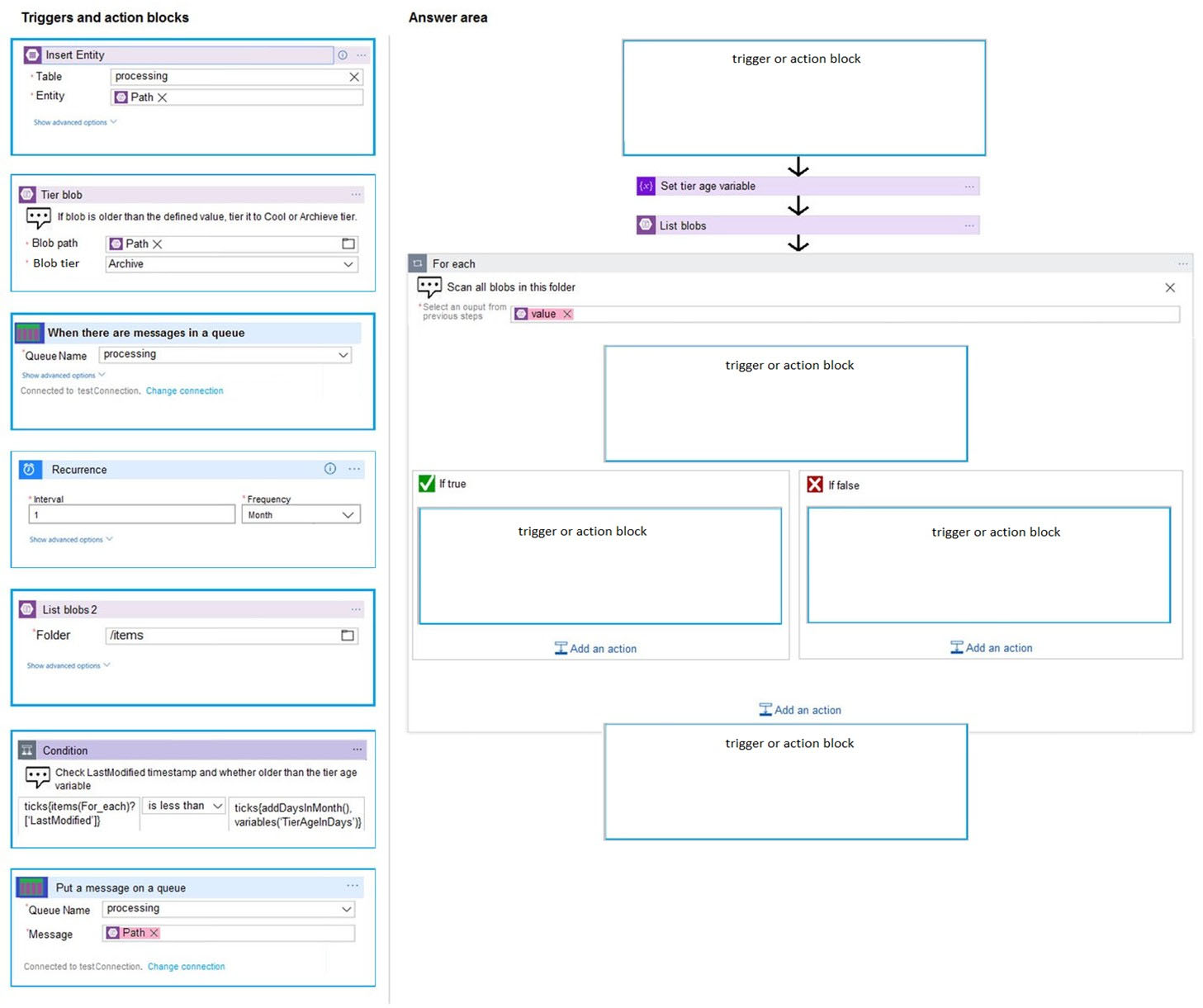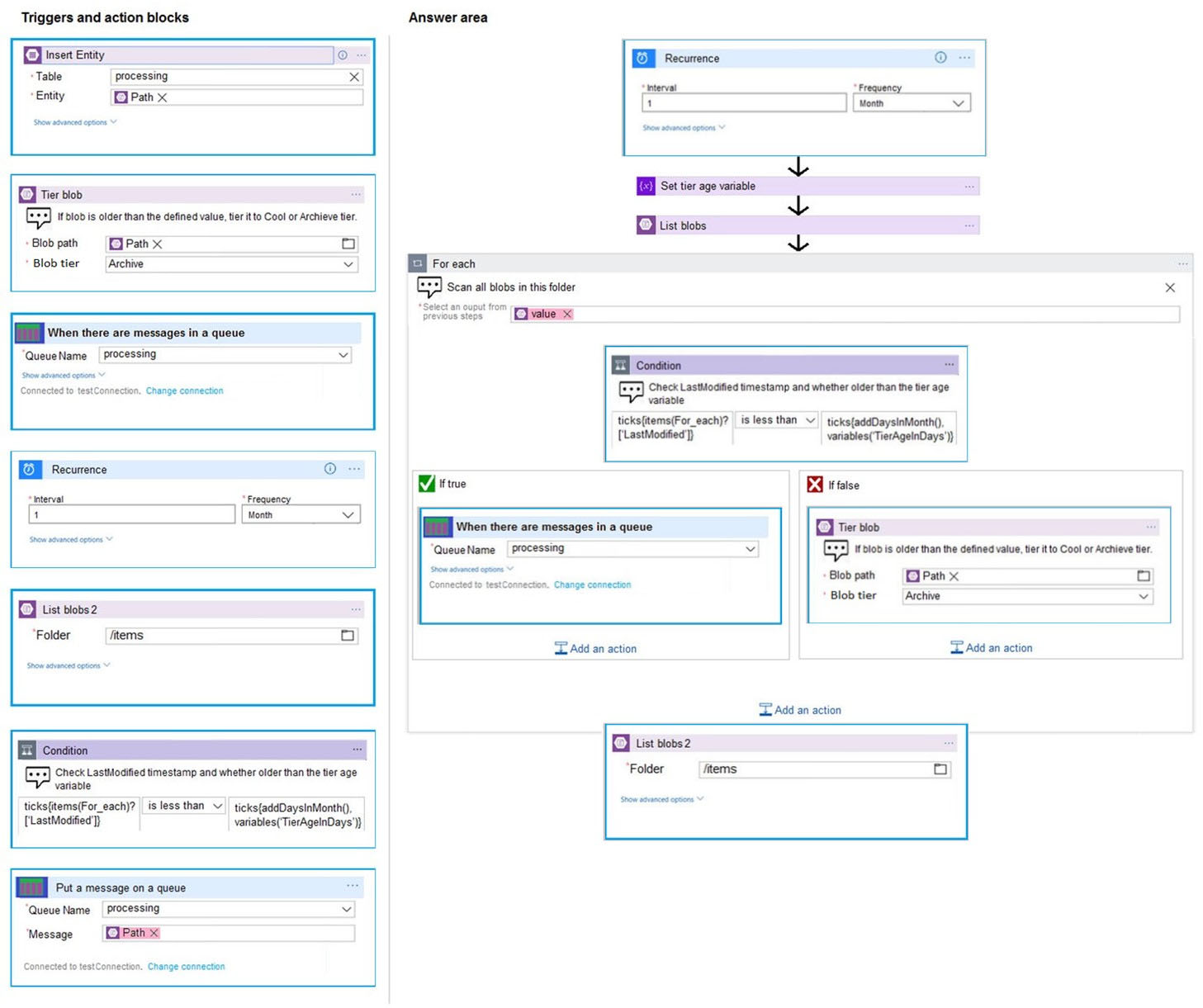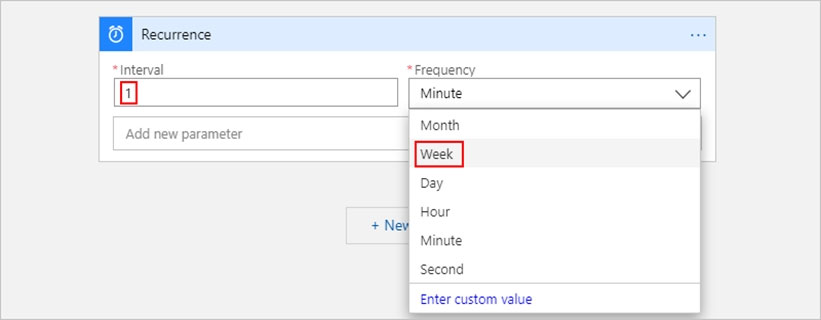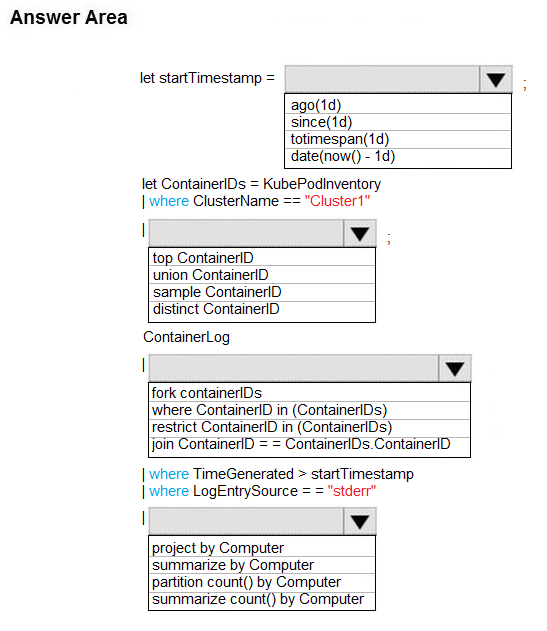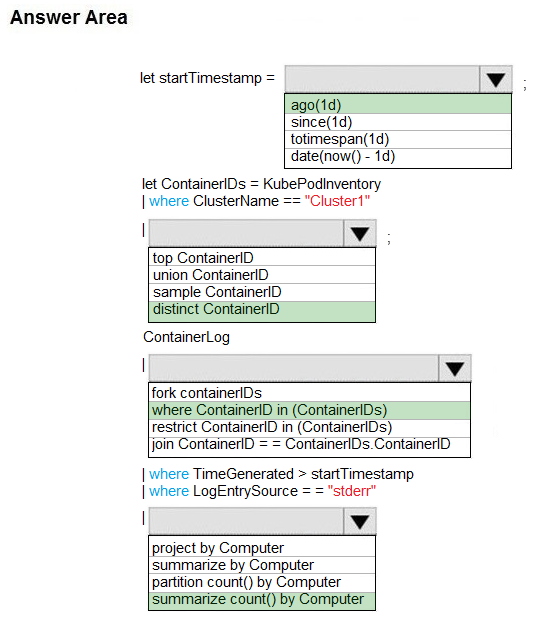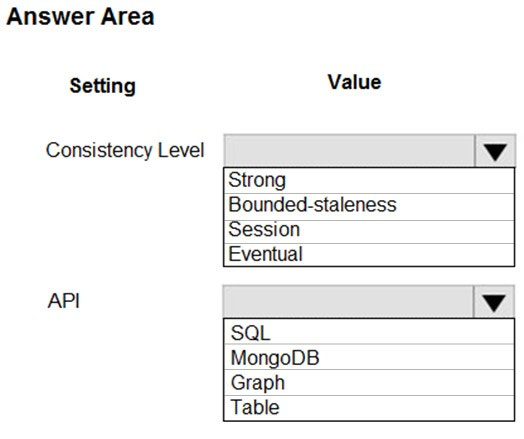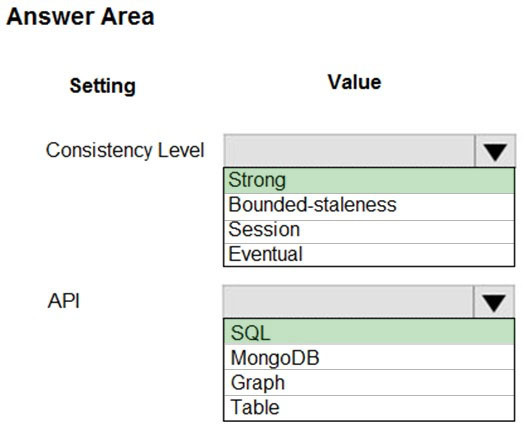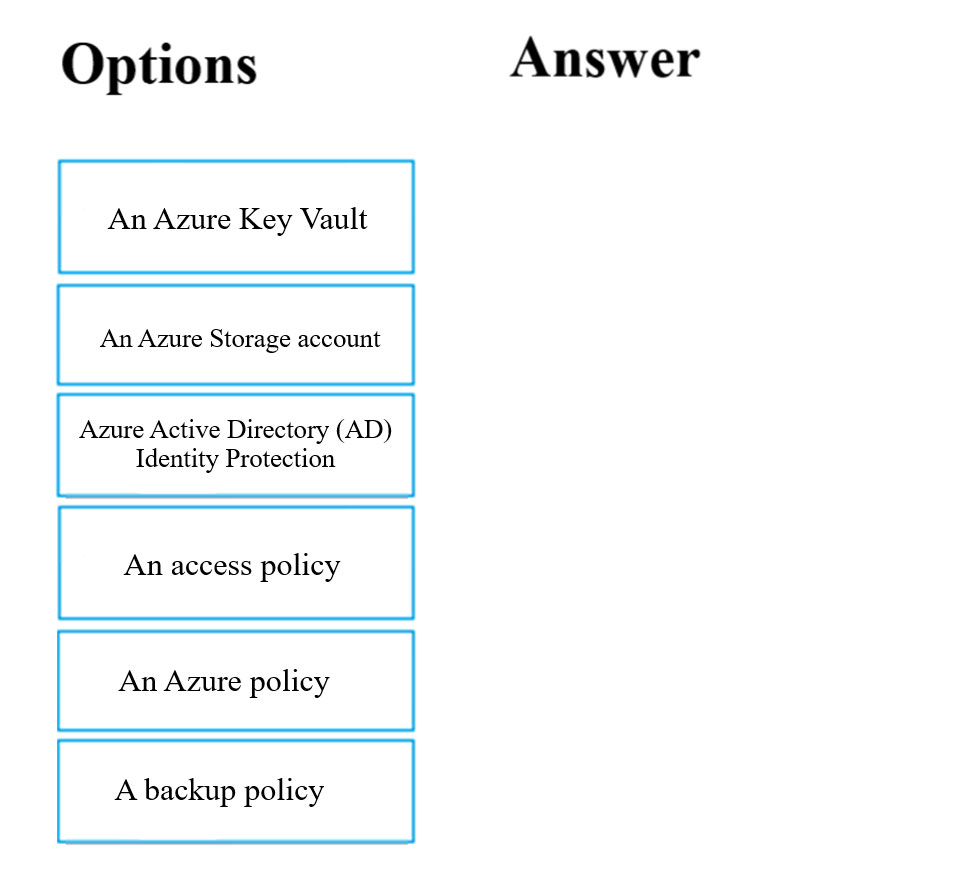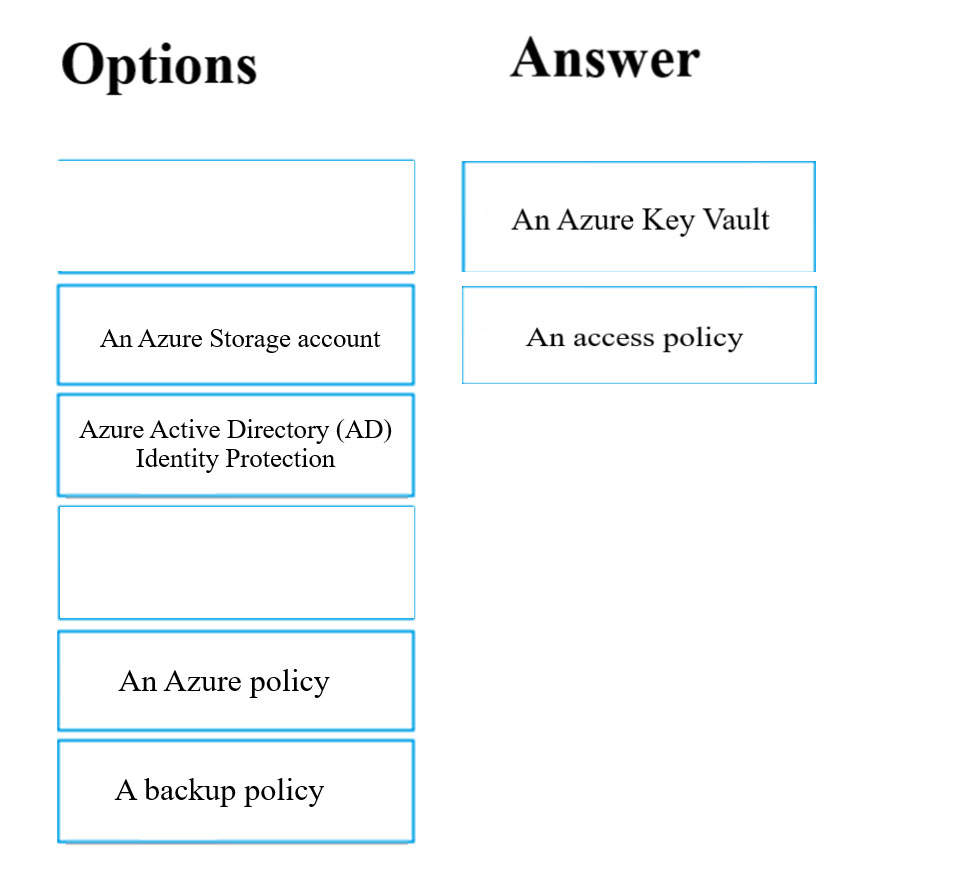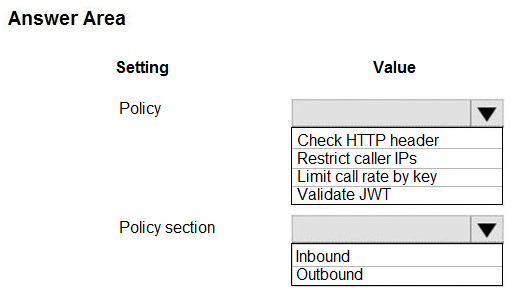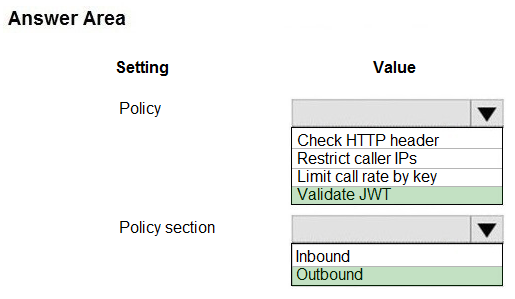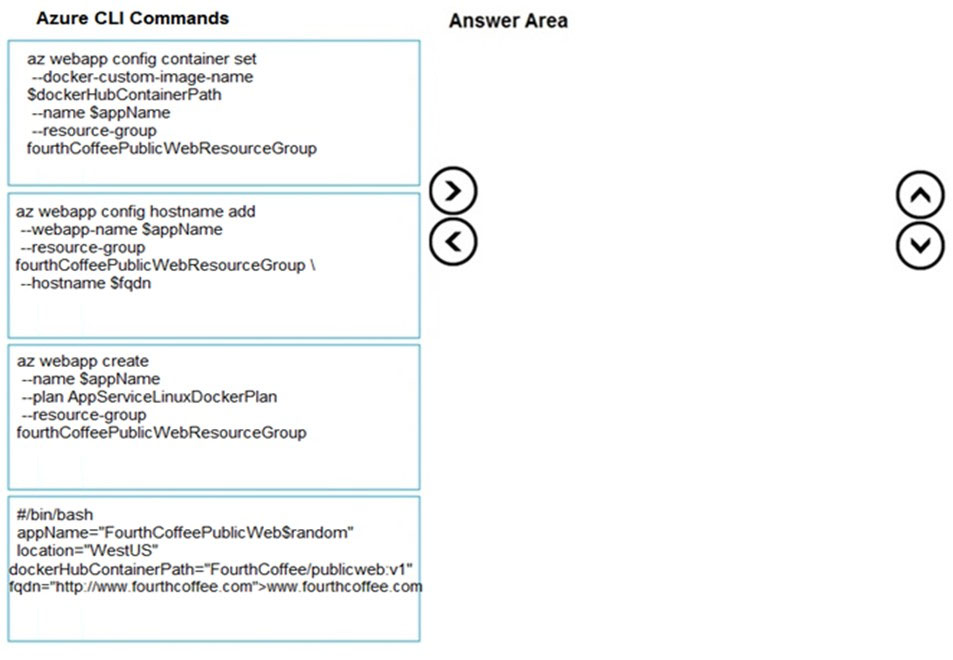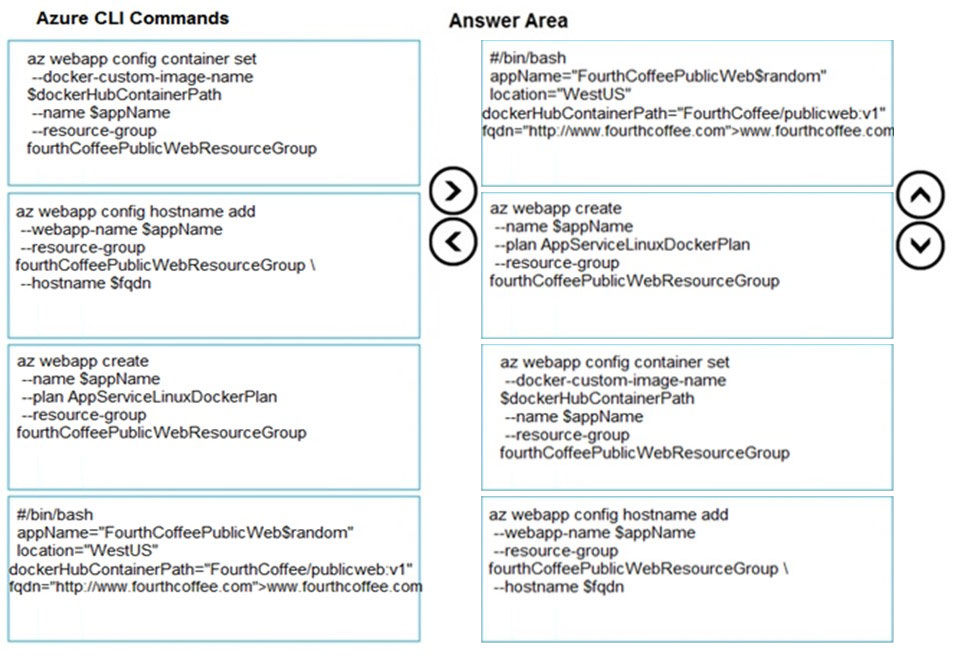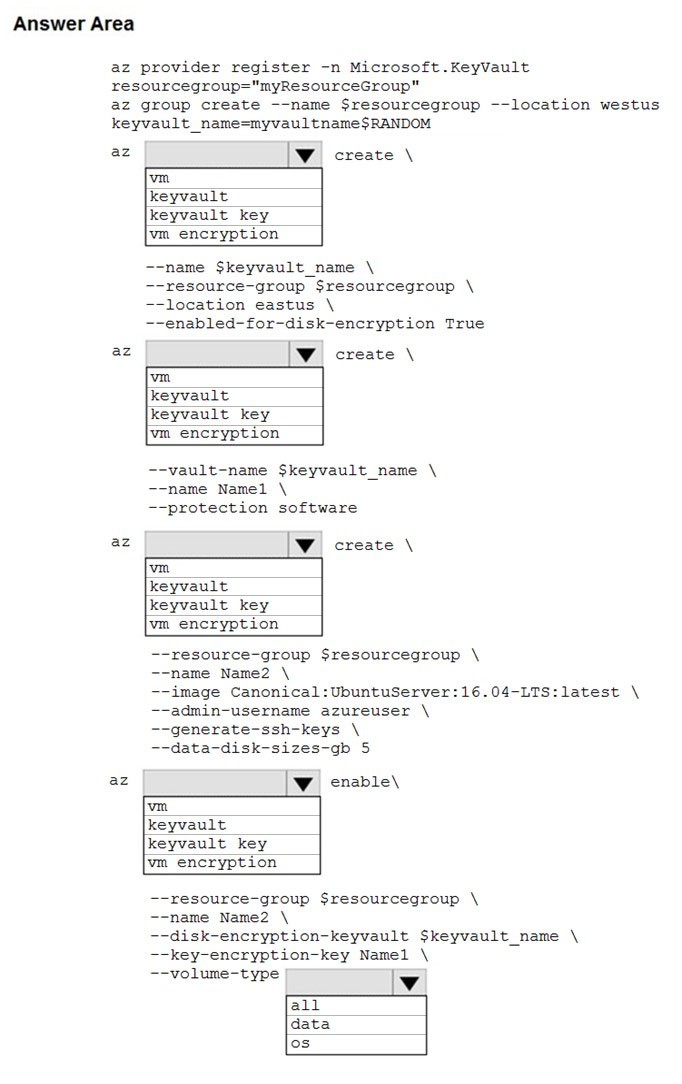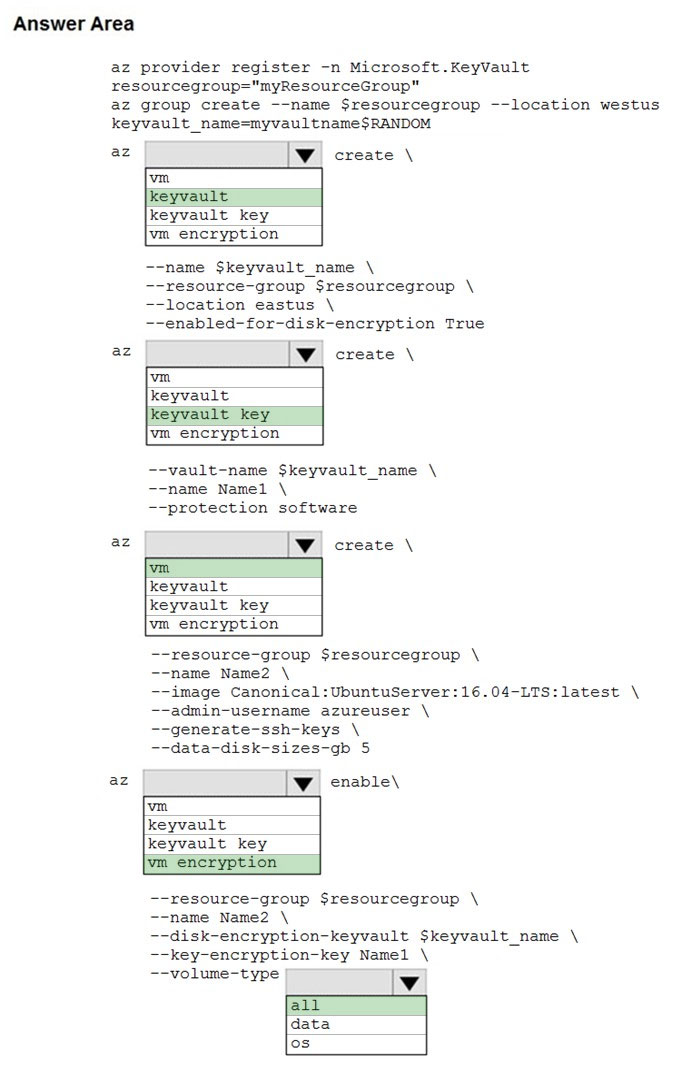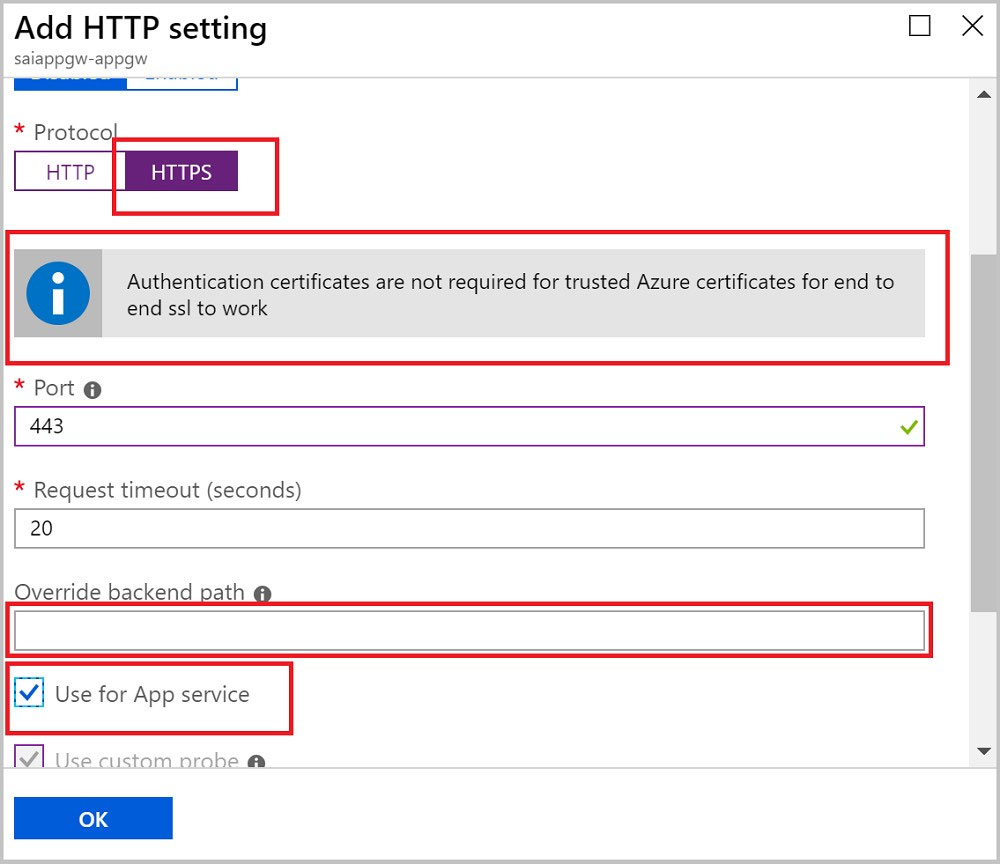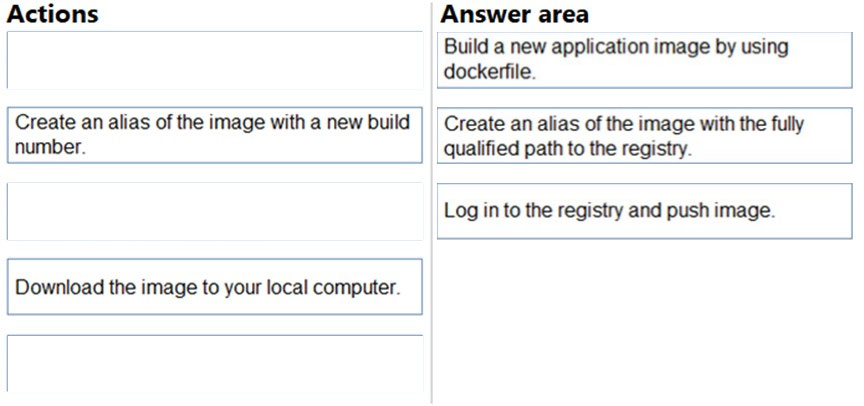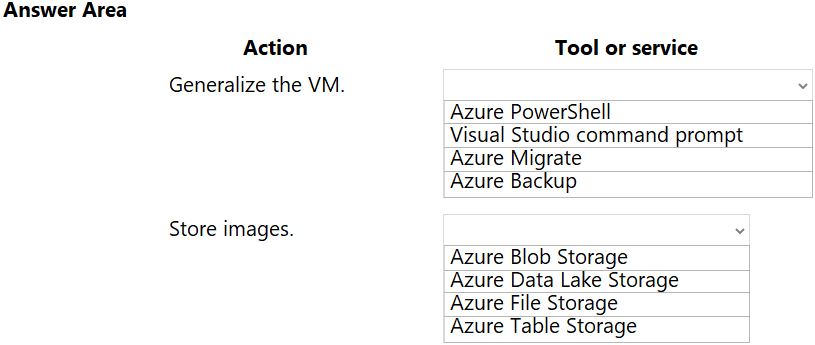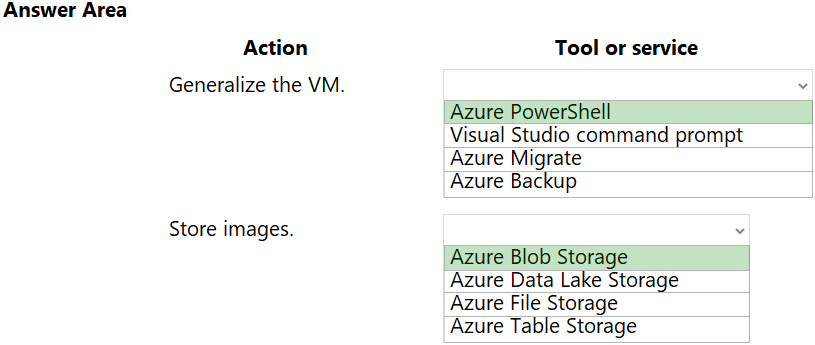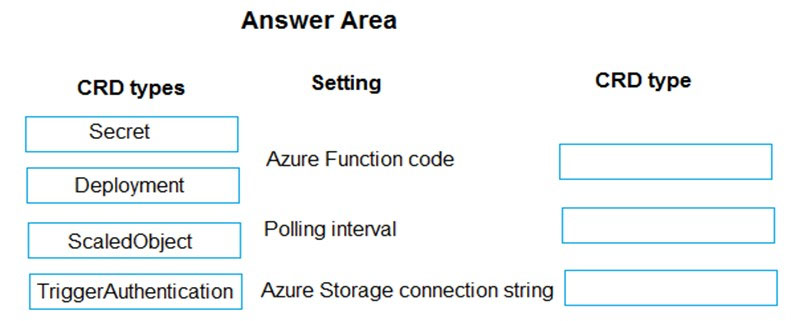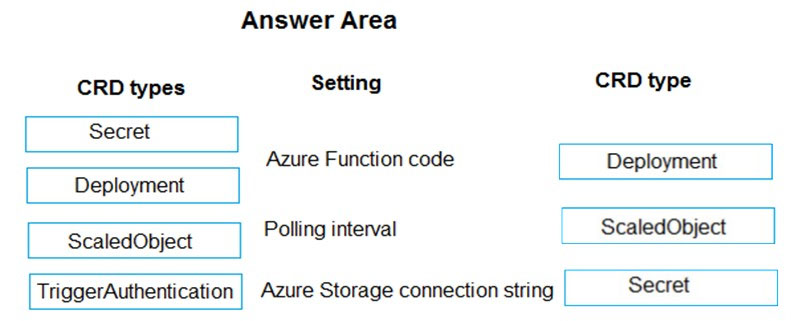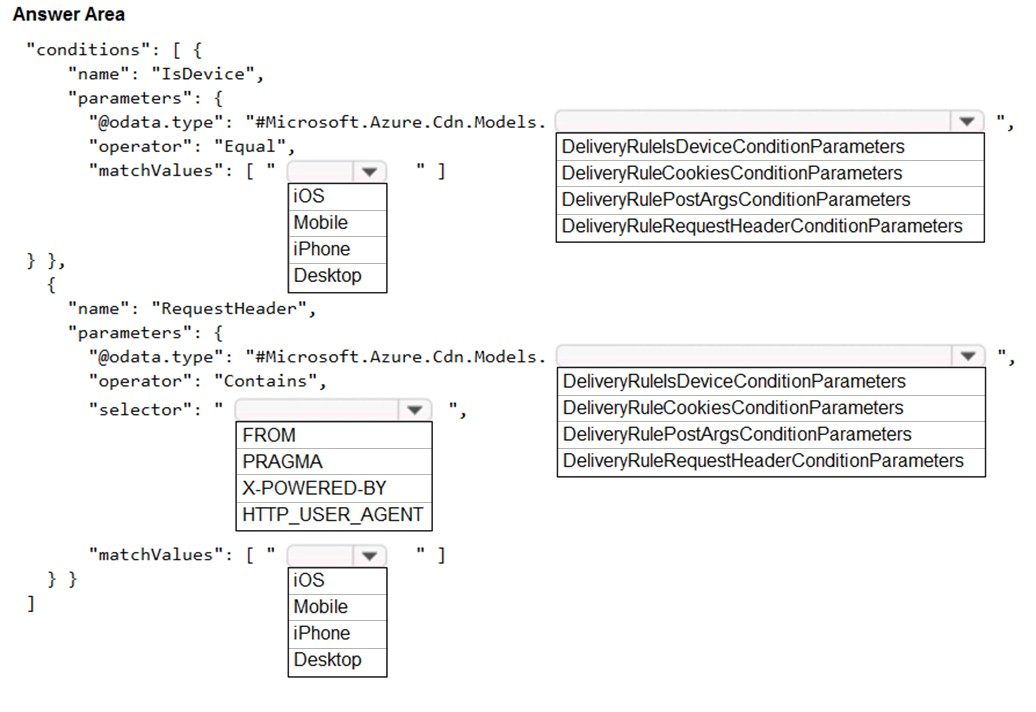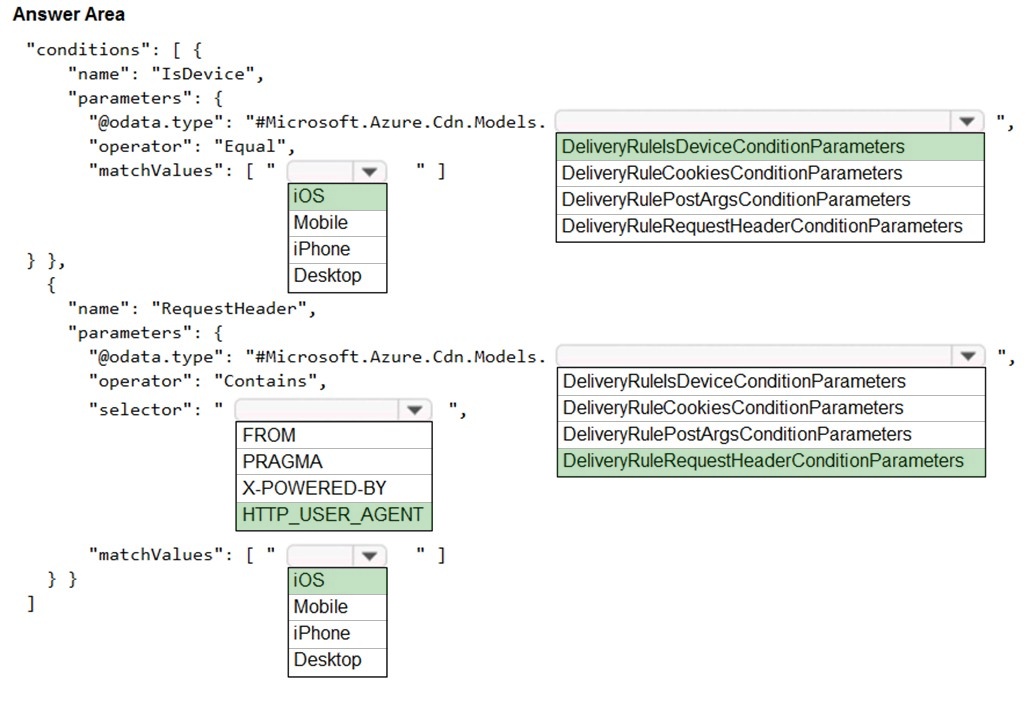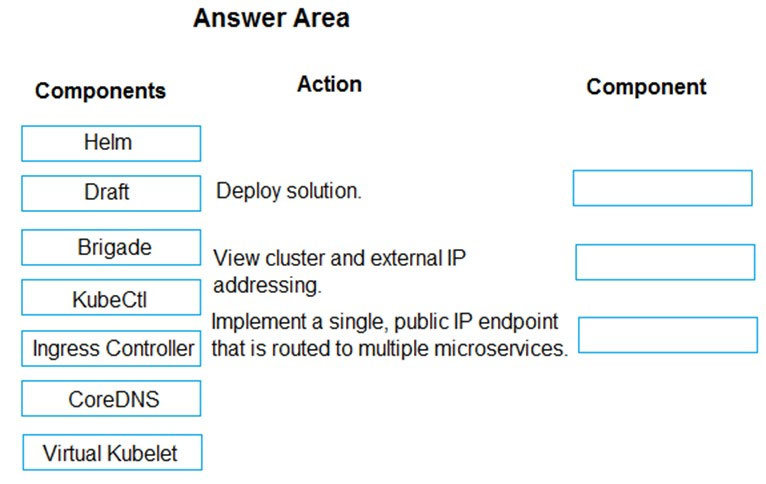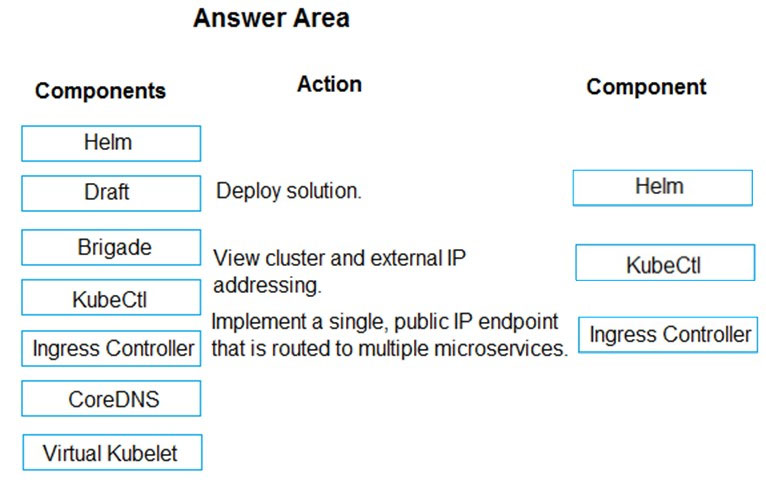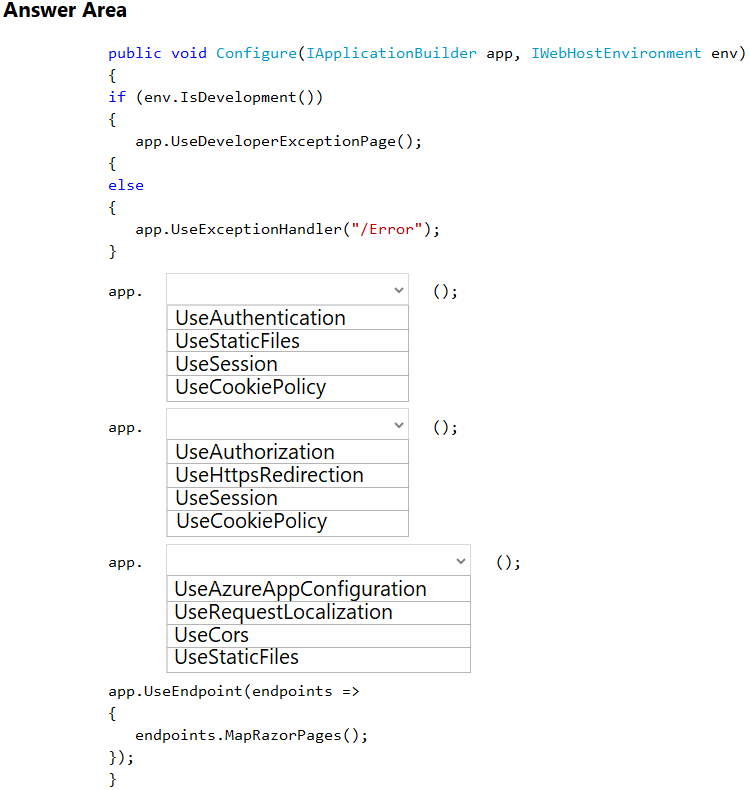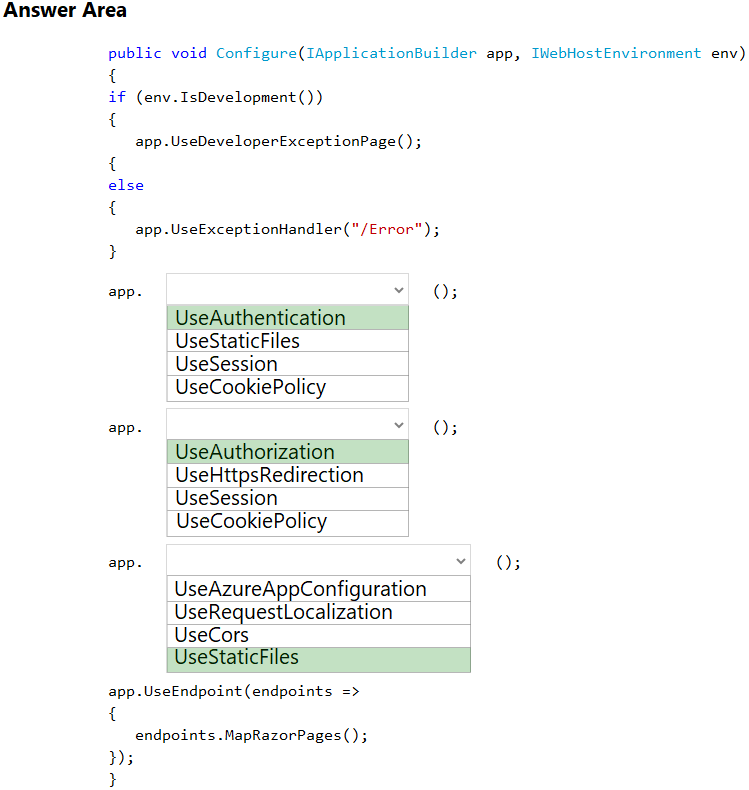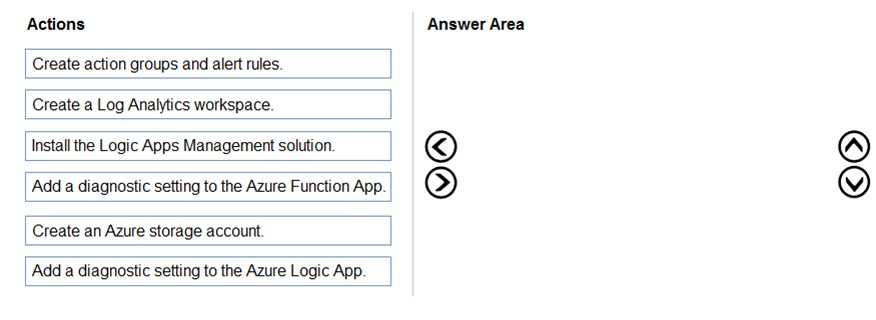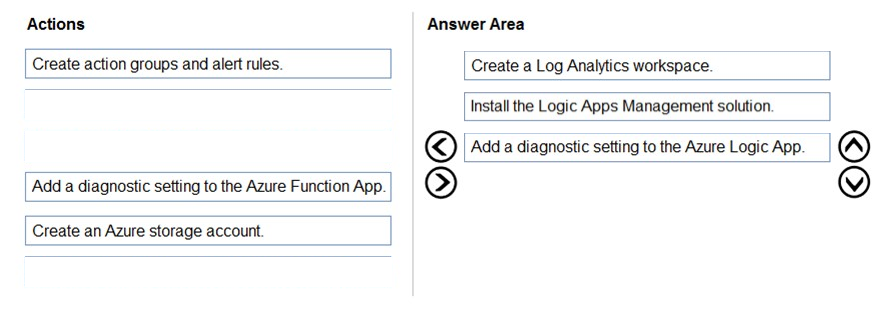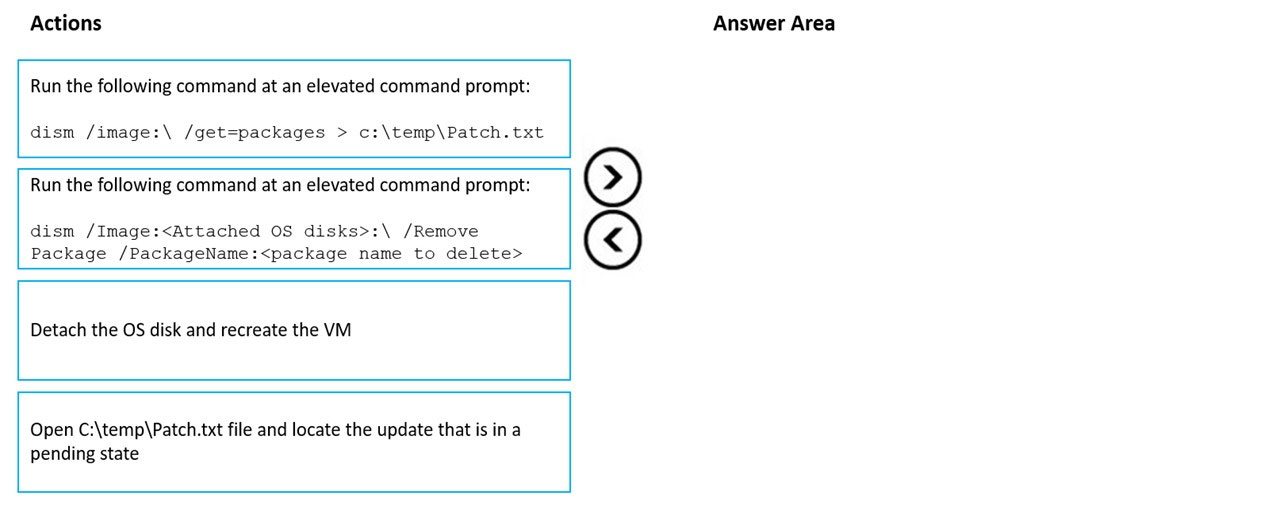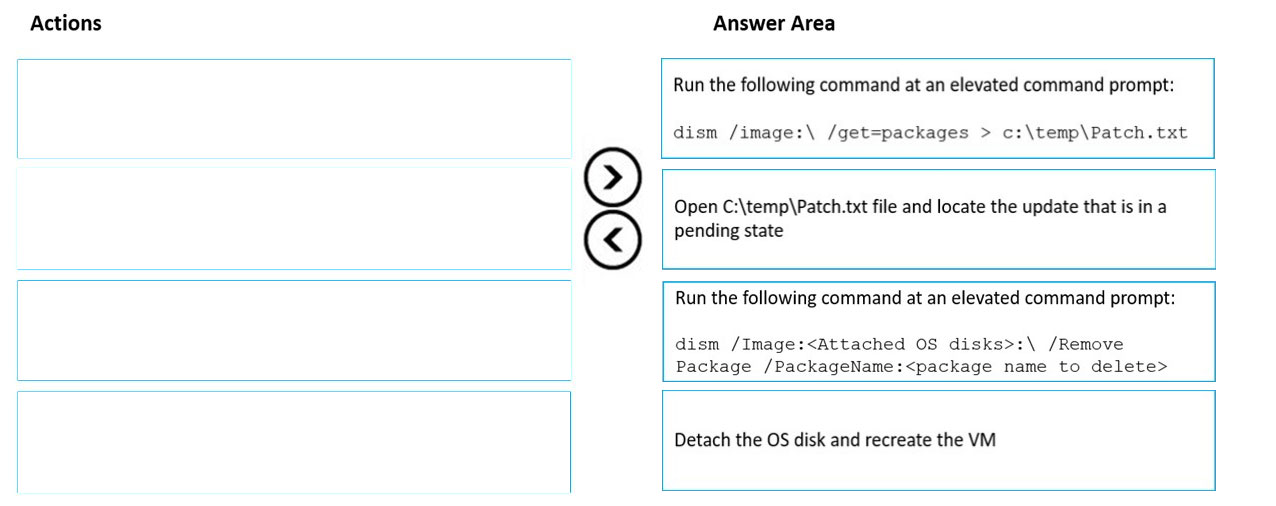AZ-204 Exam Prep Free – 50 Practice Questions to Get You Ready for Exam Day
Getting ready for the AZ-204 certification? Our AZ-204 Exam Prep Free resource includes 50 exam-style questions designed to help you practice effectively and feel confident on test day
Effective AZ-204 exam prep free is the key to success. With our free practice questions, you can:
- Get familiar with exam format and question style
- Identify which topics you’ve mastered—and which need more review
- Boost your confidence and reduce exam anxiety
Below, you will find 50 realistic AZ-204 Exam Prep Free questions that cover key exam topics. These questions are designed to reflect the structure and challenge level of the actual exam, making them perfect for your study routine.
DRAG DROP - A company backs up all manufacturing data to Azure Blob Storage. Admins move blobs from hot storage to archive tier storage every month. You must automatically move blobs to Archive tier after they have not been modified within 180 days. The path for any item that is not archived must be placed in an existing queue. This operation must be performed automatically once a month. You set the value of TierAgeInDays to -180. How should you configure the Logic App? To answer, drag the appropriate triggers or action blocks to the correct trigger or action slots. Each trigger or action block may be used once, more than once, or not at all. You may need to drag the split bar between panes or scroll to view content. NOTE: Each correct selection is worth one point. Select and Place:
After you answer a question in this section, you will NOT be able to return to it. As a result, these questions will not appear in the review screen. You develop a software as a service (SaaS) offering to manage photographs. Users upload photos to a web service which then stores the photos in Azure Storage Blob storage. The storage account type is General-purpose V2. When photos are uploaded, they must be processed to produce and save a mobile-friendly version of the image. The process to produce a mobile-friendly version of the image must start in less than one minute. You need to design the process that starts the photo processing. Solution: Create an Azure Function app that uses the Consumption hosting model and that is triggered from the blob upload. Does the solution meet the goal?
A. Yes
B. No
HOTSPOT - You are debugging an application that is running on Azure Kubernetes cluster named cluster1. The cluster uses Azure Monitor for containers to monitor the cluster. The application has sticky sessions enabled on the ingress controller. Some customers report a large number of errors in the application over the last 24 hours. You need to determine on which virtual machines (VMs) the errors are occurring. How should you complete the Azure Monitor query? To answer, select the appropriate options in the answer area. NOTE: Each correct selection is worth one point. Hot Area:
You are developing a solution for a public facing API. The API back end is hosted in an Azure App Service instance. You have implemented a RESTful service for the API back end. You must configure back-end authentication for the API Management service instance. Solution: You configure Client cert gateway credentials for the HTTP(s) endpoint. Does the solution meet the goal?
A. Yes
B. No
You are configuring a web app that delivers streaming video to users. The application makes use of continuous integration and deployment. You need to ensure that the application is highly available and that the users' streaming experience is constant. You also want to configure the application to store data in a geographic location that is nearest to the user. Solution: You include the use of an Azure Content Delivery Network (CDN) in your design. Does the solution meet the goal?
A. Yes
B. No
You are creating a hazard notification system that has a single signaling server which triggers audio and visual alarms to start and stop. You implement Azure Service Bus to publish alarms. Each alarm controller uses Azure Service Bus to receive alarm signals as part of a transaction. Alarm events must be recorded for audit purposes. Each transaction record must include information about the alarm type that was activated. You need to implement a reply trail auditing solution. Which two actions should you perform? Each correct answer presents part of the solution. NOTE: Each correct selection is worth one point.
A. Assign the value of the hazard message SessionID property to the ReplyToSessionId property.
B. Assign the value of the hazard message MessageId property to the DevileryCount property.
C. Assign the value of the hazard message SessionID property to the SequenceNumber property.
D. Assign the value of the hazard message MessageId property to the CorrelationId property.
E. Assign the value of the hazard message SequenceNumber property to the DeliveryCount property.
F. Assign the value of the hazard message MessageId property to the SequenceNumber property.
HOTSPOT - You need to configure Azure Cosmos DB. Which settings should you use? To answer, select the appropriate options in the answer area. NOTE: Each correct selection is worth one point. Hot Area:
HOTSPOT - You provisioned an Azure Cosmos DB for NoSQL account named account1 with the default consistency level. You plan to configure the consistency level on a per request basis. The level needs to be set for consistent prefix for read and write operations to account1. You need to identify the resulting consistency level for read and write operations. Which levels should you configure? To answer, select the appropriate options in the answer area. NOTE: Each correct selection is worth one point.
HOTSPOT - You develop two Python scripts to process data. The Python scripts must be deployed to two, separate Linux containers running in an Azure Container Instance container group. The containers must access external data by using the Server Message Block (SMB) protocol. Containers in the container group must run only once. You need to configure the Azure Container Instance. Which configuration value should you use? To answer, select the appropriate options in the answer area. NOTE: Each correct selection is worth one point.
DRAG DROP - You have downloaded an Azure Resource Manager template to deploy numerous virtual machines. The template is based on a current virtual machine, but must be adapted to reference an administrative password. You need to make sure that the password is not stored in plain text. You are preparing to create the necessary components to achieve your goal. Which of the following should you create to achieve your goal? Answer by dragging the correct option from the list to the answer area. Select and Place:
You develop Azure Durable Functions to manage vehicle loans. The loan process includes multiple actions that must be run in a specified order. One of the actions includes a customer credit check process, which may require multiple days to process. You need to implement Azure Durable Functions for the loan process. Which Azure Durable Functions type should you use?
A. orchestrator
B. client
C. entity
D. activity
HOTSPOT - You need to configure API Management for authentication. Which policy values should you use? To answer, select the appropriate options in the answer area. NOTE: Each correct selection is worth one point. Hot Area:
After you answer a question in this section, you will NOT be able to return to it. As a result, these questions will not appear in the review screen. You are developing an Azure solution to collect point-of-sale (POS) device data from 2,000 stores located throughout the world. A single device can produce 2 megabytes (MB) of data every 24 hours. Each store location has one to five devices that send data. You must store the device data in Azure Blob storage. Device data must be correlated based on a device identifier. Additional stores are expected to open in the future. You need to implement a solution to receive the device data. Solution: Provision an Azure Event Hub. Configure the machine identifier as the partition key and enable capture. Does the solution meet the goal?
A. Yes
B. No
DRAG DROP - Fourth Coffee has an ASP.NET Core web app that runs in Docker. The app is mapped to the www.fourthcoffee.com domain. Fourth Coffee is migrating this application to Azure. You need to provision an App Service Web App to host this docker image and map the custom domain to the App Service web app. A resource group named FourthCoffeePublicWebResourceGroup has been created in the WestUS region that contains an App Service Plan named AppServiceLinuxDockerPlan. Which order should the CLI commands be used to develop the solution? To answer, move all of the Azure CLI commands from the list of commands to the answer area and arrange them in the correct order. Select and Place:
You need to audit the retail store sales transactions. What are two possible ways to achieve the goal? Each correct answer presents a complete solution. NOTE: Each correct selection is worth one point.
A. Update the retail store location data upload process to include blob index tags. Create an Azure Function to process the blob index tags and filter by store location.
B. Process the change feed logs of the Azure Blob storage account by using an Azure Function. Specify a time range for the change feed data.
C. Enable blob versioning for the storage account. Use an Azure Function to process a list of the blob versions per day.
D. Process an Azure Storage blob inventory report by using an Azure Function. Create rule filters on the blob inventory report.
E. Subscribe to blob storage events by using an Azure Function and Azure Event Grid. Filter the events by store location.
HOTSPOT - You have an Azure API Management instance named API1 that uses a managed gateway. You plan to implement a policy that will apply at a product scope and will set the header of inbound requests to include information about the region hosting the gateway of API1. The policy definition contains the following content:You have the following requirements for the policy definition: • Ensure that the header contains the information about the region hosting the gateway of API1. • Ensure the policy applies only after any global level policies are processed first. You need to complete the policy definition. Which values should you choose? To answer, select the appropriate options in the answer area. NOTE: Each correct selection is worth one point.
After you answer a question in this section, you will NOT be able to return to it. As a result, these questions will not appear in the review screen. You develop a software as a service (SaaS) offering to manage photographs. Users upload photos to a web service which then stores the photos in Azure Storage Blob storage. The storage account type is General-purpose V2. When photos are uploaded, they must be processed to produce and save a mobile-friendly version of the image. The process to produce a mobile-friendly version of the image must start in less than one minute. You need to design the process that starts the photo processing. Solution: Trigger the photo processing from Blob storage events. Does the solution meet the goal?
A. Yes
B. No
HOTSPOT - You are developing an application to store millions of images in Azure blob storage. The application has the following requirements: • Store the Exif (exchangeable image file format) data from the image as blob metadata when the application uploads the image. • Retrieve the Exif data from the image while minimizing bandwidth and processing time. • Utilizes the REST API. You need to use the image Exif data as blob metadata in the application. Which HTTP verbs should you use? To answer, select the appropriate options in the answer area. NOTE: Each correct selection is worth one point.
DRAG DROP - You develop an Azure solution that uses Cosmos DB. The current Cosmos DB container must be replicated and must use a partition key that is optimized for queries. You need to implement a change feed processor solution. Which change feed processor components should you use? To answer, drag the appropriate components to the correct requirements. Each component may be used once, more than once, or not at all. You may need to drag the split bar between panes or scroll to view the content. NOTE: Each correct selection is worth one point. Select and Place:
You need to implement a solution to resolve the retail store location data issue. Which three Azure Blob features should you enable? Each correct answer presents part of the solution. NOTE: Each correct selection is worth one point.
A. Soft delete
B. Change feed
C. Snapshots
D. Versioning
E. Object replication
F. Immutability
HOTSPOT - You plan to develop an Azure Functions app with an HTTP trigger. The app must support the following requirements: • Event-driven scaling • Ability to use custom Linux images for function execution You need to identify the app’s hosting plan and the maximum amount of time that the app function can take to respond to incoming requests. Which configuration setting values should you use? To answer, select the appropriate values in the answer area. NOTE: Each correct selection is worth one point.
HOTSPOT - You plan to deploy a new application to a Linux virtual machine (VM) that is hosted in Azure. The entire VM must be secured at rest by using industry-standard encryption technology to address organizational security and compliance requirements. You need to configure Azure Disk Encryption for the VM. How should you complete the Azure CLI commands? To answer, select the appropriate options in the answer area. NOTE: Each correct selection is worth one point. Hot Area:
You are developing a web app that is protected by Azure Web Application Firewall (WAF). All traffic to the web app is routed through an Azure Application Gateway instance that is used by multiple web apps. The web app address is contoso.azurewebsites.net. All traffic must be secured with SSL. The Azure Application Gateway instance is used by multiple web apps. You need to configure the Azure Application Gateway for the web app. Which two actions should you perform? Each correct answer presents part of the solution. NOTE: Each correct selection is worth one point.
A. In the Azure Application Gateway’s HTTP setting, enable the Use for App service setting.
B. Convert the web app to run in an Azure App service environment (ASE).
C. Add an authentication certificate for contoso.azurewebsites.net to the Azure Application Gateway.
D. In the Azure Application Gateway’s HTTP setting, set the value of the Override backend path option to contoso22.azurewebsites.net.
DRAG DROP - Case study - This is a case study. Case studies are not timed separately. You can use as much exam time as you would like to complete each case. However, there may be additional case studies and sections on this exam. You must manage your time to ensure that you are able to complete all questions included on this exam in the time provided. To answer the questions included in a case study, you will need to reference information that is provided in the case study. Case studies might contain exhibits and other resources that provide more information about the scenario that is described in the case study. Each question is independent of the other questions in this case study. At the end of this case study, a review screen will appear. This screen allows you to review your answers and to make changes before you move to the next section of the exam. After you begin a new section, you cannot return to this section. To start the case study - To display the first question in this case study, click the Next button. Use the buttons in the left pane to explore the content of the case study before you answer the questions. Clicking these buttons displays information such as business requirements, existing environment, and problem statements. When you are ready to answer a question, click the Question button to return to the question. Background - Munson’s Pickles and Preserves Farm is an agricultural cooperative corporation based in Washington, US, with farms located across the United States. The company supports agricultural production resources by distributing seeds fertilizers, chemicals, fuel, and farm machinery to the farms. Current Environment - The company is migrating all applications from an on-premises datacenter to Microsoft Azure. Applications support distributors, farmers, and internal company staff. Corporate website - • The company hosts a public website located at http://www.munsonspicklesandpreservesfarm.com. The site supports farmers and distributors who request agricultural production resources. Farms - • The company created a new customer tenant in the Microsoft Entra admin center to support authentication and authorization for applications. Distributors - • Distributors integrate their applications with data that is accessible by using APIs hosted at http://www.munsonspicklesandpreservesfarm.com/api to receive and update resource data. Requirements - The application components must meet the following requirements: Corporate website - • The site must be migrated to Azure App Service. • Costs must be minimized when hosting in Azure. • Applications must automatically scale independent of the compute resources. • All code changes must be validated by internal staff before release to production. • File transfer speeds must improve, and webpage-load performance must increase. • All site settings must be centrally stored, secured without using secrets, and encrypted at rest and in transit. • A queue-based load leveling pattern must be implemented by using Azure Service Bus queues to support high volumes of website agricultural production resource requests. Farms - • Farmers must authenticate to applications by using Microsoft Entra ID. Distributors - • The company must track a custom telemetry value with each API call and monitor performance of all APIs. • API telemetry values must be charted to evaluate variations and trends for resource data. Internal staff - • App and API updates must be validated before release to production. • Staff must be able to select a link to direct them back to the production app when validating an app or API update. • Staff profile photos and email must be displayed on the website once they authenticate to applications by using their Microsoft Entra ID. Security - • All web communications must be secured by using TLS/HTTPS. • Web content must be restricted by country/region to support corporate compliance standards. • The principle of least privilege must be applied when providing any user rights or process access rights. • Managed identities for Azure resources must be used to authenticate services that support Microsoft Entra ID authentication. Issues - Corporate website - • Farmers report HTTP 503 errors at the same time as internal staff report that CPU and memory usage are high. • Distributors report HTTP 502 errors at the same time as internal staff report that average response times and networking traffic are high. • Internal staff report webpage load sizes are large and take a long time to load. • Developers receive authentication errors to Service Bus when they debug locally. Distributors - • Many API telemetry values are sent in a short period of time. Telemetry traffic, data costs, and storage costs must be reduced while preserving a statistically correct analysis of the data points sent by the APIs. You need to correct the internal staff issue with webpages. Which three actions should you perform in sequence? To answer, move the appropriate actions from the list of actions to the answer area and arrange them in the correct order.
HOTSPOT - You develop new functionality in a web application for a company that provides access to seismic data from around the world. The seismic data is stored in Redis Streams within an Azure Cache for Redis instance. The new functionality includes a real-time display of seismic events as they occur. You need to implement the Azure Cache for Redis command to receive seismic data. How should you complete the command? To answer, select the appropriate options in the answer area. NOTE: Each correct selection is worth one point.
You develop and deploy an ASP.NET Core application that connects to an Azure Database for MySQL instance. Connections to the database appear to drop intermittently and the application code does not handle the connection failure. You need to handle the transient connection errors in code by implementing retries. What are three possible ways to achieve this goal? Each correct answer presents part of the solution. NOTE: Each correct selection is worth one point.
A. Close the database connection and immediately report an error.
B. Disable connection pooling and configure a second Azure Database for MySQL instance.
C. Wait five seconds before repeating the connection attempt to the database.
D. Set a maximum number of connection attempts to 10 and report an error on subsequent connections.
E. Increase connection repeat attempts exponentially up to 120 seconds.
HOTSPOT - You develop an application that sells AI generated images based on user input. You recently started a marketing campaign that displays unique ads every second day. Sales data is stored in Azure Cosmos DB with the date of each sale being stored in a property named ‘whenFinished’. The marketing department requires a view that shows the number of sales for each unique ad. You need to implement the query for the view. How should you complete the query? To answer, select the appropriate options in the answer area. NOTE: Each correct selection is worth one point.
DRAG DROP - You need to deploy a new version of the LabelMaker application to ACR. Which three actions should you perform in sequence? To answer, move the appropriate actions from the list of actions to the answer area and arrange them in the correct order. Select and Place:
HOTSPOT - You are developing an application that runs in several customer Azure Kubernetes Service clusters. Within each cluster, a pod runs that collects performance data to be analyzed later. A large amount of data is collected so saving latency must be minimized. The performance data must be stored so that pod restarts do not impact the stored data. Write latency should be minimized. You need to configure blob storage. How should you complete the YAML configuration? To answer, select the appropriate options in the answer area. NOTE: Each correct selection is worth one point.
HOTSPOT - You have an App Service plan named asp1 based on the Free pricing tier. You plan to use asp1 to implement an Azure Function app with a queue trigger. Your solution must minimize cost. You need to identify the configuration options that will meet the requirements. Which value should you configure? To answer, select the appropriate options in the answer area. NOTE: Each correct selection is worth one point.
You are developing an Azure App Service web app. The web app must securely store session information in Azure Redis Cache. You need to connect the web app to Azure Redis Cache. Which three Azure Redis Cache properties should you use? Each correct answer presents part of the solution. NOTE: Each correct selection is worth one point.
A. Access key
B. SSL port
C. Subscription name
D. Location
E. Host name
F. Subscription id
You are a developer at your company. You need to edit the workflows for an existing Logic App. What should you use?
A. the Enterprise Integration Pack (EIP)
B. the Logic App Code View
C. the API Connections
D. the Logic Apps Designer
You need to investigate the http server log output to resolve the issue with the ContentUploadService. Which command should you use first?
A. az webapp log
B. az ams live-output
C. az monitor activity-log
D. az container attach
After you answer a question in this section, you will NOT be able to return to it. As a result, these questions will not appear in the review screen. You develop a software as a service (SaaS) offering to manage photographs. Users upload photos to a web service which then stores the photos in Azure Storage Blob storage. The storage account type is General-purpose V2. When photos are uploaded, they must be processed to produce and save a mobile-friendly version of the image. The process to produce a mobile-friendly version of the image must start in less than one minute. You need to design the process that starts the photo processing. Solution: Convert the Azure Storage account to a BlockBlobStorage storage account. Does the solution meet the goal?
A. Yes
B. No
HOTSPOT - You are configuring a development environment for your team. You deploy the latest Visual Studio image from the Azure Marketplace to your Azure subscription. The development environment requires several software development kits (SDKs) and third-party components to support application development across the organization. You install and customize the deployed virtual machine (VM) for your development team. The customized VM must be saved to allow provisioning of a new team member development environment. You need to save the customized VM for future provisioning. Which tools or services should you use? To answer, select the appropriate options in the answer area. NOTE: Each correct selection is worth one point. Hot Area:
DRAG DROP - You are a developer for a software as a service (SaaS) company that uses an Azure Function to process orders. The Azure Function currently runs on an Azure Function app that is triggered by an Azure Storage queue. You are preparing to migrate the Azure Function to Kubernetes using Kubernetes-based Event Driven Autoscaling (KEDA). You need to configure Kubernetes Custom Resource Definitions (CRD) for the Azure Function. Which CRDs should you configure? To answer, drag the appropriate CRD types to the correct locations. Each CRD type may be used once, more than once, or not at all. You may need to drag the split bar between panes or scroll to view content. NOTE: Each correct selection is worth one point. Select and Place:
HOTSPOT - You are building a website that is used to review restaurants. The website will use an Azure CDN to improve performance and add functionality to requests. You build and deploy a mobile app for Apple iPhones. Whenever a user accesses the website from an iPhone, the user must be redirected to the app store. You need to implement an Azure CDN rule that ensures that iPhone users are redirected to the app store. How should you complete the Azure Resource Manager template? To answer, select the appropriate options in the answer area. NOTE: Each correct selection is worth one point. Hot Area:
DRAG DROP - You are developing a microservices solution. You plan to deploy the solution to a multinode Azure Kubernetes Service (AKS) cluster. You need to deploy a solution that includes the following features: ✑ reverse proxy capabilities ✑ configurable traffic routing ✑ TLS termination with a custom certificate Which components should you use? To answer, drag the appropriate components to the correct requirements. Each component may be used once, more than once, or not at all. You may need to drag the split bar between panes or scroll to view content. NOTE: Each correct selection is worth one point. Select and Place:
You develop Azure Web Apps for a commercial diving company. Regulations require that all divers fill out a health questionnaire every 15 days after each diving job starts. You need to configure the Azure Web Apps so that the instance count scales up when divers are filling out the questionnaire and scales down after they are complete. You need to configure autoscaling. What are two possible auto scaling configurations to achieve this goal? Each correct answer presents a complete solution. NOTE: Each correct selection is worth one point.
A. Recurrence profile
B. CPU usage-based autoscaling
C. Fixed date profile
D. Predictive autoscaling
HOTSPOT - You develop a web app that interacts with Azure Active Directory (Azure AD) groups by using Microsoft Graph. You build a web page that shows all Azure AD groups that are not of the type 'Unified'. You need to build the Microsoft Graph query for the page. How should you complete the query? To answer, select the appropriate options in the answer area. NOTE: Each correct selection is worth one point.
After you answer a question in this section, you will NOT be able to return to it. As a result, these questions will not appear in the review screen. You develop an HTTP triggered Azure Function app to process Azure Storage blob data. The app is triggered using an output binding on the blob. The app continues to time out after four minutes. The app must process the blob data. You need to ensure the app does not time out and processes the blob data. Solution: Configure the app to use an App Service hosting plan and enable the Always On setting. Does the solution meet the goal?
A. Yes
B. No
HOTSPOT - You are developing an application that needs access to an Azure virtual machine (VM). The access lifecycle for the application must be associated with the VM service instance. You need to enable managed identity for the VM. How should you complete the PowerShell segment? To answer, select the appropriate options in the answer area. NOTE: Each correct selection is worth one point. Hot Area:
You are developing a web application that uses the Microsoft identity platform to authenticate users and resources. The web application calls several REST APIs. The APIs require an access token from the Microsoft identity platform. You need to request a token. Which three properties should you use? Each correct answer presents part of the solution. NOTE: Each correct selection is worth one point.
A. Redirect URI/URL
B. Application ID
C. Application name
D. Application secret
E. Supported account type
You need to deploy the CheckUserContent Azure Function. The solution must meet the security and cost requirements. Which hosting model should you use?
A. Premium plan
B. App Service plan
C. Consumption plan
You develop and deploy an Azure App Service web app. The app is deployed to multiple regions and uses Azure Traffic Manager. Application Insights is enabled for the app. You need to analyze app uptime for each month. Which two solutions will achieve the goal? Each correct answer presents a complete solution. NOTE: Each correct selection is worth one point.
A. Azure Monitor logs
B. Application Insights alerts
C. Azure Monitor metrics
D. Application Insights web tests
HOTSPOT - You are developing an ASP.NET Core app that includes feature flags which are managed by Azure App Configuration. You create an Azure App Configuration store named AppFeatureFlagStore that contains a feature flag named Export. You need to update the app to meet the following requirements: ✑ Use the Export feature in the app without requiring a restart of the app. ✑ Validate users before users are allowed access to secure resources. ✑ Permit users to access secure resources. How should you complete the code segment? To answer, select the appropriate options in the answer area. NOTE: Each correct selection is worth one point. Hot Area:
DRAG DROP - You develop and deploy an Azure Logic App that calls an Azure Function app. The Azure Function App includes an OpenAPI (Swagger) definition and uses an Azure Blob storage account. All resources are secured by using Azure Active Directory (Azure AD). The Logic App must use Azure Monitor logs to record and store information about runtime data and events. The logs must be stored in the Azure Blob storage account. You need to set up Azure Monitor logs and collect diagnostics data for the Azure Logic App. Which three actions should you perform in sequence? To answer, move the appropriate actions from the list of actions to the answer area and arrange them in the correct order. Select and Place:
DRAG DROP - You provision virtual machines (VMs) as development environments. One VM does not start. The VM is stuck in a Windows update process. You attach the OS disk for the affected VM to a recovery VM. You need to correct the issue. In which order should you perform the actions? To answer, move the appropriate actions from the list of actions to the answer area and arrange them in the correct order. Select and Place:
You are building a web application that performs image analysis on user photos and returns metadata containing objects identified. The image analysis is very costly in terms of time and compute resources. You are planning to use Azure Redis Cache so duplicate uploads do not need to be reprocessed. In case of an Azure data center outage, metadata loss must be kept to a minimum. You need to configure the Azure Redis cache instance. Which two actions should you perform? Each correct answer presents part of the solution. NOTE: Each correct selection is worth one point.
A. Configure Azure Redis with AOF persistence.
B. Configure Azure Redis with RDB persistence.
C. Configure second storage account for persistence.
D. Set backup frequency to the minimum value.
You are developing an Azure messaging solution. You need to ensure that the solution meets the following requirements: ✑ Provide transactional support. ✑ Provide duplicate detection. ✑ Store the messages for an unlimited period of time. Which two technologies will meet the requirements? Each correct answer presents a complete solution. NOTE: Each correct selection is worth one point.
A. Azure Service Bus Topic
B. Azure Service Bus Queue
C. Azure Storage Queue
D. Azure Event Hub
Access Full AZ-204 Exam Prep Free
Want to go beyond these 50 questions? Click here to unlock a full set of AZ-204 exam prep free questions covering every domain tested on the exam.
We continuously update our content to ensure you have the most current and effective prep materials.
Good luck with your AZ-204 certification journey!


